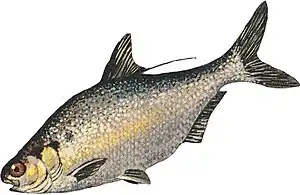Dorosoma
Dorosoma is a genus that contains five species of shads, within the family Dorosomatidae. The five species are native to the North and/or Central America, and are mostly known from fresh water, though some may reside in the waters of estuaries and bays.[1][2]
| Dorosoma | |
|---|---|
 | |
| Dorosoma cepedianum | |
| Scientific classification | |
| Domain: | Eukaryota |
| Kingdom: | Animalia |
| Phylum: | Chordata |
| Class: | Actinopterygii |
| Order: | Clupeiformes |
| Family: | Dorosomatidae |
| Genus: | Dorosoma Rafinesque, 1820 |
| Species | |
|
See text | |
The American gizzard shad is important to the food web in America due to being a source of game fish food. They also have a long history of stock introductions that can lead to disruptions to the food web.[3]
Species
- Dorosoma anale Meek, 1904 (Mexican river gizzard shad)
- Dorosoma cepedianum (Lesueur, 1818) (American gizzard shad)
- Dorosoma chavesi Meek, 1907 (Nicaragua gizzard shad)
- Dorosoma petenense (Günther, 1867) (threadfin shad)
- Dorosoma smithi C. L. Hubbs & R. R. Miller, 1941 (Pacific gizzard shad)
References
- "Genus: Dorosoma, Shad Herrings, Shads". Smithsonian Tropical Research Institute. 2015. Retrieved 1 January 2023.
- Froese, Rainer and Pauly, Daniel, eds. (2023). Species of Dorosoma in FishBase. January 2023 version.
- "USGS Fact Sheet for Gizzard Shad". USGS.gov. 2020-08-06. Archived from the original on 2011-11-09. Retrieved 2020-08-06.
This article is issued from Wikipedia. The text is licensed under Creative Commons - Attribution - Sharealike. Additional terms may apply for the media files.